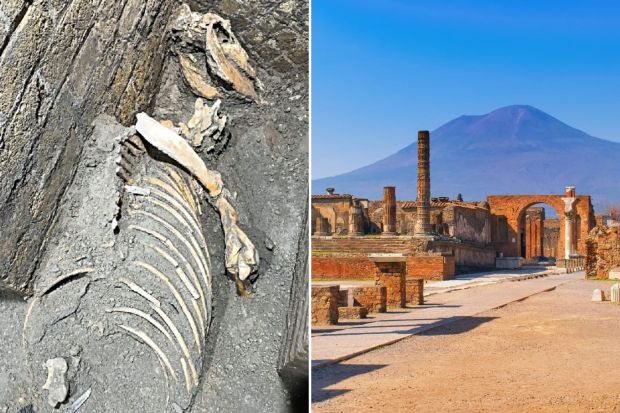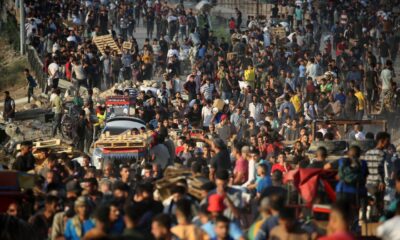Science
Archaeologists Uncover Evidence of Roman Return to Pompeii

New archaeological findings have revealed that Romans returned to the ancient city of Pompeii following the catastrophic eruption of Mount Vesuvius in 79 AD. This eruption buried the city in volcanic ash, leading to the long-held belief that survivors fled and never came back. Recent excavations, however, provide compelling evidence of a post-eruption settlement, altering our understanding of life in Pompeii after its destruction nearly two millennia ago.
New Insights into Post-Eruption Life
Research indicates that while the wealthy may have abandoned the area, the poorer inhabitants returned, driven by the hope of salvaging valuables left behind. Many of these returnees transformed the ground floors of their homes into cellars, equipping them with ovens and mills, while the upper floors saw some habitation. According to Gabriel Zuchtriegel, the director of the Pompeii Archaeological Park, the city re-emerged less as a vibrant urban center and more as a precarious settlement, akin to a camp or favela among the ruins.
Zuchtriegel explained that previous excavations often overlooked signs of this reoccupation in their haste to uncover Pompeii’s stunning frescoes and intact homes. He stated, “The momentous episode of the city’s destruction in 79 AD has monopolised the memory,” underscoring the need for a broader understanding of the city’s history.
Understanding Pompeii’s Demise and Aftermath
The exact death toll from the eruption remains uncertain, but estimates suggest that between 15% and 20% of Pompeii’s population perished due to the thermal shock from the volcanic cloud. The eruption was so powerful that the thermal energy released was estimated to be a hundred thousand times that of the nuclear blasts at Hiroshima and Nagasaki. For approximately 1,500 years, the city remained lost until rediscovered in 1599 and extensively excavated in the subsequent centuries.
The remains of Pompeii have been remarkably preserved due to the lack of air and moisture beneath the ash layers. Archaeologists have used techniques such as injecting plaster into voids left by decomposed bodies to recreate the poses of victims at the moment of their deaths.
Mount Vesuvius, which has erupted around three dozen times since 79 AD, poses an ongoing threat to millions living nearby. Although currently classified as dormant, experts consider it an “extremely active” volcano.
Recent discoveries continue to shed light on the lives of those who lived at the base of this formidable mountain. In February 2023, excavations at thermal baths in Pompeii revealed the skeleton of a child who perished during the eruption, highlighting the human cost of this natural disaster.
As excavations progress, researchers anticipate uncovering more about the resilience of those who returned to Pompeii, offering a nuanced view of life in the shadow of one of history’s most devastating volcanic eruptions. The ongoing research underscores the importance of understanding the full narrative of Pompeii, not just as a site of destruction, but also as a testament to human endurance and adaptation in the face of disaster.
-

 Entertainment1 week ago
Entertainment1 week agoAimee Osbourne Joins Family for Emotional Tribute to Ozzy
-

 Politics2 weeks ago
Politics2 weeks agoDanny Healy-Rae Considers Complaint After Altercation with Garda
-

 Top Stories3 weeks ago
Top Stories3 weeks agoFianna Fáil TDs Urgently Consider Maire Geoghegan-Quinn for Presidency
-

 World3 weeks ago
World3 weeks agoHawaii Commemorates 80 Years Since Hiroshima Bombing with Ceremony
-

 World3 weeks ago
World3 weeks agoGaza Aid Distribution Tragedy: 20 Killed Amid Ongoing Violence
-

 World3 weeks ago
World3 weeks agoCouple Convicted of Murdering Two-Year-Old Grandson in Wales
-

 Top Stories3 weeks ago
Top Stories3 weeks agoClashes Erupt Between Far-Right Groups and Migrants in Spain
-

 World3 weeks ago
World3 weeks agoAristocrat Constance Marten and Partner Convicted of Infant Murder
-

 Top Stories3 weeks ago
Top Stories3 weeks agoHistoric Dalkey Pub The Queens Reopens Under New Management
-

 World3 weeks ago
World3 weeks agoTrump Defends FBI Deputy Director Amid Epstein Files Controversy
-

 Business3 weeks ago
Business3 weeks agoSunshine 106.8 Boosts Irish Music After Regulator’s Request
-

 Politics3 weeks ago
Politics3 weeks agoTragic Crowd Surge at Gaza Aid Center Claims 20 Lives









